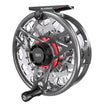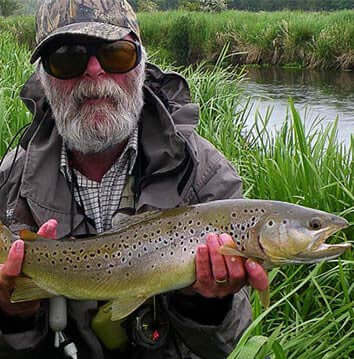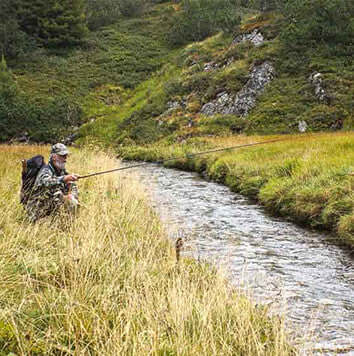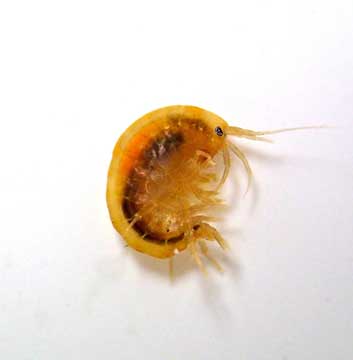Since childhood I’ve been madly interested in wildlife and fishing. It was in the late 1960s, whilst studying biology at York University, that I first became aware of Driffield Beck’s significant place in fly fishing history and its international ecological importance. At that time I envied those with the money and contacts who had the privilege to fish for the trout and grayling that were so abundant and so highly visible in my local chalk stream’s gin clear waters. Fortunately I am now in the position to walk and fish the Beck’s hallowed banks.
The fishing on the Beck is famous worldwide. The top most sections, from its head waters to a little below Bradshaw’s Mill, are controlled by the prestigious Driffield Anglers, a club established in 1883. Below this, on the Dixon’s farm, is the Mulberry Whin beat, a mile of water that was once part of the Driffield Anglers’ water but is now available on day ticket to any one. Below this the fishing is controlled by the Golden Hill Club, and then downstream from Wansford Bridge a good length is fished by members of the West Beck Preservation Society.
Driffield Beck and its smaller sister, Foston or Kelk Beck are the most northerly chalk streams of any significant size in the UK. (There are a few tiny chalk brooks such as Settrington Beck that flow from the north side of the Yorkshire Wolds). It is the chalk of the Wolds that makes these streams so unique. Chalk streams are confined to the east and south of the UK and northern France and nowhere else in the world. This makes them very important. They provide a very rich and stable habitat for a great diversity of species, not just fish but also invertebrates and plant life. This stability is conferred by the fact that the water in them comes primarily from springs that bubble out of the chalk aquifers. Rain, falling on the porous chalk of the Wolds filters through the rock, sometimes taking over a year to reach the springs at the base of the Wolds.
When it emerges it is rich in dissolved calcium a vital element for the skeletons of vertebrates, shells of molluscs and muscle function of all animals, plus the cell walls of plants. Also its temperature is a constant 10 degrees Celsius, both summer and winter, perfect for organisms such as trout that require high oxygen levels since oxygen is more soluble in cold water and water temperatures much above 20 degrees C are lethal to trout and grayling, plus many invertebrates. Furthermore, unlike most rivers, these do not suffer from sudden floods as the rain’s journey through the chalk rock evens out the rainfall ensuring that any water level changes are slow, with river levels gently rising from December into spring then gently dropping throughout the summer and autumn. All these factors help to support a rich flora and fauna. Extensive beds of Ranunculus (Water Buttercup) and other aquatic plants provide food and shelter for vast numbers of invertebrates: I have found up to 25 000 per meter squared when I have been collecting invertebrates from the river. The most abundant of these are Gammarus (Fresh Water Shrimps and Cased Caddis larvae). These are the food of the trout, grayling, minnows and chub, which themselves are food for the kingfishers, herons, otters, mink and cormorants.

Driffield West Beck in summer.
The latter two species of predator are a big problem with regard to the ecological balance of the river. Mink have devastated the once common water vole (Ratty of Wind in the Willows), whilst cormorants, once confined to the sea, have invaded our inland waterways, with flocks of 300 or more having been seen on Driffield Beck during recent winters. Cormorants have virtually wiped out the grayling, chub and other shoal fish from the river. Trout have been less adversely affected since they seek cover when threatened unlike the shoal fish that just mill about and fall easy prey to a predator that they never evolved to cope with.
Fortunately there is an active trapping scheme for mink but cormorants are at the moment a protected species. I am however pleased to say that we have a thriving otter population and only a couple of days prior to writing this, whilst fishing just below Wansford Bridge, I spent a fascinating half hour at dusk watching a mother otter and her well grown kit frolicking along the rivers edge, often within a couple of feet of me as I stood motionless in the bankside reeds. Encouragingly fewer cormorants have been seen over the last couple of years & there are pleasing signs of an increase in the numbers of wild trout, grayling, chub, dace & roach in the river. The last 3 species are confined to the lower parts of the river, below Mulberry Whin.
Much of the land along the rivers margins is designated as a SSSI (Site of Special Scientific Interest). These marshy water meadows not only provide habitat for the water vole and hunting grounds for the barn owl, but they also have a rich flora that includes early marsh orchids, twayblade orchids, common spotted orchids, bog bean, flea bane and a host of other plant species. Much conservation work is being done in these areas. The Yorkshire Wild Life Trust has recently bought extensive areas below Wansford, including Ken Ryder’s old fish ponds, whilst upstream at Mulberry Whin farmers Andrew and Brian Dixon have devoted large areas along the river to wild life and have created a wide belt either side of the river where there is no arable farming so that chemical inputs such as fertilisers and pesticides do not enter the riverine habitat.
Andrew and Brian, the East Yorkshire Rivers Trust (of which I am a trustee), students from Bishop Burton College, many members of the angling clubs that fish the river and the Yorkshire Wild Life Trust have also done much work along the river to improve the aquatic habitat by narrowing it in places to increase flow and scour the spawning gravels, introducing suitable sized spawning gravel, protecting banks from erosion, weed cutting and introducing woody debris into the river.

The author with a 5lb wild Driffield Beck brown trout.
There is much concern about the health of our chalk streams. Abstraction of vast amounts of water for domestic and agricultural use has increased dramatically over the last 50 years and has seriously reduced summer flows (hence the need for river narrowing work). Furthermore there have been increases in diffuse pollution from agro-chemicals, trout farms and road-runoff. No longer does the Driffield Beck hold the vast shoals of grayling that were once so abundant that they were considered to be vermin by the trout fishermen. Roach and dace have disappeared from the upper parts of river. Wild trout are far less common than they once were and insect species like the Blue-winged Olive (Serratella ignita) that were once abundant are now relatively rare.
This malaise is true of most of the UK’s chalk streams (fortunately apparently less so in France). Although a shadow of what it once was Driffield Beck still provides some good fishing. Its richness promotes very fast fish growth and grayling over 3 pounds in weight (considered by anglers as the fish of a lifetime) are caught every year, whilst brown trout of over 4 pounds are quite regularly caught by those with the skills to first locate them then to cast an artificial fly with accuracy and delicacy. Whether the slow insidious decline of our chalk streams is allowed to continue depends upon all of us. We need to consider our use of water carefully, both individually and at a government level. Water is not a limitless resource to be squandered without thought and our rivers should not be just a way to dispose of our waste. Our environment is too precious to exploit without thought of the consequences. The European Water Framework Directive is legislation aimed at returning our rivers and waterways to a decent ecological status (most are dismally failing at the present time). Hopefully the WFD will be acted upon rather than just given ‘lip service’ like the issue of Global Warming and CO2 emissions.
Only time will tell if Brexit has any impact upon the Government’s attitude to the environment & whether is a positive one or whether big business and greed will win out. Jeremy Lucas has mentioned in his blogs how healthy the French chalk streams are. Maybe one day UK chalk streams might be brought back to what they should be; pure waters with good flows, limited siltation and plenty of wild fish, rather than polluted, silted drains with low flows & stocked to death with tame, oversized brown & rainbow trout to compensate for poor habitat, cormorant predation & anglers who want easy fishing for minimal skill & effort.

Grayling populations have declined drastically over recent years, mainly due to cormorant predation, but there are still some huge ones in the river if you can locate them.
The fishing on Mulberry Whin beat is now controlled by Sunray’s Will Robins who is aiming to reduce the stocking of farmed brown trout so that the wild fish can thrive. He has also changed the rules such that within reason all legitimate fly fishing methods may be used rather than the highly restrictive traditional chalkstream rules of upstream dry fly & nymph only. The fishing is all catch & release except for any escapee rainbows from the local trout farm that must be removed. Having fished with Will a few weeks before completing this Blog I can confirm that there are plenty of trout in the fishery, with a good proportion of them being hard fighting wild fish, plus a few huge grayling clearly visible on the open patches of gravel.
The fishing on the Mulberry Whin beat, day ticket water, will be controlled by http://www.precision-fly.com from the start of 2017.
www.ywt.org.uk/ (Yorkshire Wildlife Trust)






















